Machinery Characteristics
-
- SNAME Annual Meeting Maritime Reporter, Nov 1978 #12
Robert T. Young, president of The Society of Naval Architects and Marine Engineers, has announced the complete schedule for SNAME's 86th Annual Meeting to be held on November 16-18, 1978, at The New York Hilton Hotel.
The meeting actually begins on Wednesday afternoon, November 15, with the yearly Council meeting.
Technical sessions take place Thursday and Friday, and the evening events include the Annual Banquet on Friday and the Dinner-Dance on Saturday.
At the simultaneous technical sessions, 14 papers will be presented.
These have been specially selected so they present enough variety to interest all the attendees.
President Young will give his final message as president at the President's Luncheon in the Sutton Ballroom on Thursday the 16th. Featured on the program will be the presentation of several important awards—the Cochrane Award and the Joseph Linnard Prize. In the afternoon, at 4:00 p.m., the Annual Business Session will be held, where the members will act to elect a new president for a two-year term beginning January 1, 1979.
On Friday evening, the 17th, the Annual Banquet will take place in the Grand Ballroom. After the dinner, the Taylor, Land, and Davidson Medals will be presented.
The Banquet speaker will be Charles W. Robinson, vicechairman, Blyth Eastman Dillon & Co., Incorporated.
The David W. Taylor Medal, "For Notable Achievement in Naval Architecture and Marine Engineering," will be awarded to John J. Nachtsheim, Assistant A d m i n i s t r a t o r for Operations, Maritime Administration. The Vice Admiral "Jerry" Land Medal, "For Outstanding Accomplishment in the Marine Field," will be given to Rear Adm. William M. Benkert, USCG (ret.), president of the American Institute of Merchant Shipping. The Davidson Medal, awarded every other year, will be presented to Dr. Louis Landweber, p r o f e s s o r and research engineer, University of Iowa.
The 14 technical papers to be presented are: Paper No. 1—"Ship Sway, Roll, and Yaw Motions in Oblique Seas" by Rodney T. Schmitke.
Synopsis—A theoretical model is presented for the prediction of ship sway, roll and yaw motions in oblique seas. The low-frequency behavior of this model is examined, with emphasis on beam seas.
The prediction of roll damping is discussed in detail, including examples.
Extensive comparisons of predicted and measured roll response are made.
Paper No. 2—"Wave Statistics for the Design of Ships and Ocean Structures" by Michel K. Ochi.
Synopsis—This paper presents wave information needed for predicting responses of ocean systems in a seaway, specifically for design consideration. A series of wave spectra to be used for shortterm, as well as a series for longterm ( l i f e t i m e ) predictions are developed. Numerical computations are made on a semisubmersible platform; results are compared with those using wave spectra measured at various global locations.
Paper No. 3 — "Analysis and Control of Distortion in Welded Aluminum Structures" by Koichi Masubuchi and Vassilios J. Papazoglou.
Synopsis — Results of recent investigations on the subject are summarized. Three kinds of welding distortion are analyzed: longitudinal bending distortion, outof- plane angular distortion, and buckling distortion. Experimental results are presented and compared with predictions obtained by computer programs.
Paper No. 4 — "Effect of Hull Girder Stiffness Variations on Ship Structural Performance" by J. Harvey Evans and Roger G.
Kline.
Synopsis — A review of possible hull-stiffness problems reveals no cause for concern over insufficient stiffness per se. More relevant are whipping bending stress components from slamming or fatigue from springing. A procedure, based upon the "dynamic load factor" concept, is proposed for estimating whipping bending stresses during preliminary design, as a function of hull stiffness.
Paper No. 5 — "Analysis of a High-Power Water-Cooled Electric Propulsion System" by D.L.
Greene, C.J. Mole, W.P. Welch and W.R. Seng.
Synopsis—The results of a study of a new class of water-cooled d-c electric machinery, as applied to a destroyer-type ship, are reported.
The high-power density of this machine type makes it possible to take advantage of the arrangement and control flexibility of electric machines, without a volume and weight penalty. A description of expected ship performance and principal machinery characteristics is presented.
Paper No. 6—"Feasibility and Comparative Studies for the Use of Prestressed Concrete in Large Storage/Processing Vessels" by Ben C. Gerwick Jr., A.E. Mansour, Edward Price and A. Thayamballi.
Synopsis—The use of prestressed concrete for constructing storage/ processing vessels and oceangoing liquefied gas carriers may have certain advantages. The technical feasibility and safety of a 300- meter-long prestressed concrete vessel c a r r y i n g LPG in freestanding tanks is analyzed and evaluated. The results are compared with similar analysis of a steel hull designed on the basis of ABS requirements.
Paper No. 7—"Design of Bulbous Bows" by Alfred M. Kracht.
Synopsis—A quantitative design method for bulbous bows is presented, together with the necessary data, providing relationships between performance and main parameters of ships and bulbs.
The derived design charts show the power gain as functions of bulb parameters and allow the calculation of the required power of a bulb ship.
Paper No. 8 — "Prediction of Steady and Unsteady Marine Propeller Performance by Numerical Lifting-Surface Theory" by Justin E. Kerwin and Chang-Sup Lee.
Synopsis — A numerical liftingsurface theory for marine propellers has been developed at M.I.T., for use as a practical tool in the solution of both steady and unsteady flow problems. This paper presents a view of the theory and a description of the numerical methods employed, followed by systematic tests establishing the numerical convergence of the procedure and a number of specific comparisons with published experimental and theoretical data.
Paper No. 9 — "Hull Experiments on 24-Knot RO/RO Vessels Directed Toward Fuel-Saving Application of Copper-Nickel" by Eugene Schorsch, Richard T. Bicicchi and John W. Fu.
Synopsis—To evaluate coppernickel as a hull material in clad or sheathed forms for large commercial vessels, shipboard tests to determine Cu-Ni durability in h i g h - s p e e d vessel environment were performed. A rudder was sheathed and installed on a 24- knot ro/ro vessel; together with insulated and electro-chemically instrumented test panels. These tests indicated that the materials' erosion corrosion rates are within tolerable limits.
Paper No. 10—"Ice Effect Trials in Arctic Waters on CCGS Louis S. St. Laurent" by Peter G. Noble, Roderick J. Allan, Malcolm Dunne and Brian Johnson.
Synopsis — An Arctic probe was made in May 1977 with the CCGS Louis S. St. Laurent. Tests were carried out during the voyage from Nova Scotia to the western end of Lancaster Sound. Ship motions, accelerations and ice loads on the hull also were measured and are reported together with details of ice properties testing and the ship instrumentation system.
Paper No. 11 — "New Finnish Barge Carriers for the U.S.S.R." by Veikko Koskivirta, Veikko Heikkila, Mikko Niini and Heikki Harjuvaara.
Synopsis—The Finnish shipbuilding and engineering company Valmet Oy is currently constructing two 36,600-dwt barge carriers for the U.S.S.R., based on the Lykes SEABEE concept. The paper gives a brief description of the design and construction of the vessels. Main particulars of the 3,000-ton-capacity barge l i f t i n g and t r a n s f e r r i n g arrangements also are given.
Paper No. 12 — "Development and Application of a Computer- Controlled Ship's Frame Bender in the Automated Shipyard" by James B. Acton, Filippo Cali, Thomas P. Mackey and H.W.
Mergler.
Synopsis—A unique ship's frame bender with self-adaptive computer numerical control (CNC) has been developed and will be installed at NASSCO's San Diego shipyard. The CNC bender is compatible with existing shipyard automation programs using offset data generated by the shipyard's host computer, to bend or straighten frames automatically, resulting in significant cost savings and increased production efficiency.
Paper No. 13—"Modern Heavy- Lift Ships: State of the Art" by H.W. Janecke and W.F. Muir.
Synopsis—Types and concepts of modern heavy-lift ships are described and illustrated. Basic design characteristics and requirements are also discussed, together with typical heavy-lift gear and transfer equipment. Operation of heavy-lift vessels is covered with respect to planning, crewing and cargo handling. Also presented is an in-depth description of the first American-built modern heavy-lift ship.
Paper No. 14 — "Systems Approach to Offshore Crane Ship Operation" by Dan Hoffman and Vincent K. Fitzgerald.
Synopsis — The evolution of offshore crane vessels is described in relation to present design philosophy and operation criteria.
Currently employed methods of on- and off-line analysis for predicting and minimizing downtime are discussed. Actual on-site data is presented to document the substantial improvements in operability achieved by vessels employing these methods. Particular emphasis is placed upon the onboard computerized and monitoring system (HELM).
-
 )
March 2024 - Marine Technology Reporter page: 32
)
March 2024 - Marine Technology Reporter page: 32UK-based Soil Machine Dynamics (SMD) designed, devel- and has attained collection ef? ciency rates of at least 97% in oped and delivered the mining machinery planned for the recent university trials. Solwara 1 Sea? oor Massive Sulphides project some 15 years Ian Maskell, principal engineer, says: “The
-
 )
March 2024 - Marine Technology Reporter page: 30
)
March 2024 - Marine Technology Reporter page: 301970s by major Western corporations like Shell, BP and Ken- to be present and alive 12 months after having been in? uenced SMD developed the mining machinery planned for the Solwari 1 sul? des project. Image courtesy of SMD 30 March/April 2024 MTR #3 (18-33).indd 30 4/4/2024 9:15:02 A
-
 )
April 2024 - Maritime Reporter and Engineering News page: 14
)
April 2024 - Maritime Reporter and Engineering News page: 14involves associating realistic noise and below, this would bring a whole new design/built process to vibration source levels for all the salient machinery, equip- the marine industry. ment, and systems. This includes prime movers – generally The ? rst step will be how to meet these limits in a pro
-
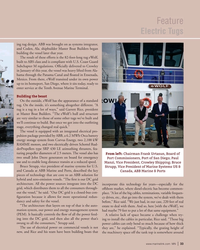 )
April 2024 - Marine News page: 33
)
April 2024 - Marine News page: 33on commercial vessels is not they are,” he explained. “Typically, the grating height of new, and Rice and his team have been building boats that the machinery space off the tank top is somewhere around www.marinelink.com MN 33
-
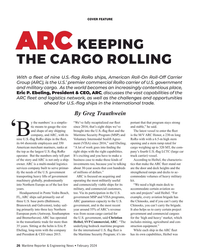 )
February 2024 - Maritime Reporter and Engineering News page: 26
)
February 2024 - Maritime Reporter and Engineering News page: 26.” strengthened ramps and decks to ac- transporting heavy lifts of government ARC is focused on acquiring and commodate volumes of heavy military machinery globally, predominantly operating the most militarily useful kit. into Northern Europe as of the last few and commercially viable ships for its
-
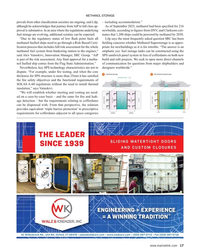 )
February 2024 - Maritime Reporter and Engineering News page: 17
)
February 2024 - Maritime Reporter and Engineering News page: 17METHANOL STORAGE provals from other classi? cation societies are ongoing, said Lilp, – including accommodation.” although he acknowledges that journey from AiP to full class ap- As of September 2023, methanol had been speci? ed for 216 proval is substantive. In an area where the regulations underlying
-
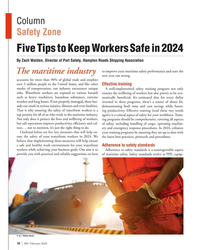 )
February 2024 - Marine News page: 18
)
February 2024 - Marine News page: 18program not only risks. Waterfront workers are exposed to various hazards ensures the wellbeing of workers but also proves to be eco- such as heavy machinery, hazardous substances, extreme nomically bene? cial. It’s estimated that for every dollar weather and long hours. If not properly managed, these
-
 )
January 2024 - Marine Technology Reporter page: 25
)
January 2024 - Marine Technology Reporter page: 25“The sky’s the limit in terms of payloads that can be brought into the vehicle.” Ann Stevens, Vice President, Boeing Maritime & Intelligence Systems subsea vehicles, speci? cally vehicles with increased endurance nautical miles. “You can go for months at a time without requir- to allow them to be deployed
-
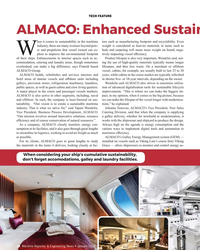 )
January 2024 - Maritime Reporter and Engineering News page: 38
)
January 2024 - Maritime Reporter and Engineering News page: 38of marine vessels and offshore units including in shorter ? ve- or 10-year intervals, depending on the owner. galleys, provision stores, refrigeration machinery, laundries, Wendelin said ALMACO also strives to maximize utiliza- public spaces, as well as guest cabins and crew living quarters. tion of advanced
-
 )
January 2024 - Maritime Reporter and Engineering News page: 20
)
January 2024 - Maritime Reporter and Engineering News page: 20holds All images courtesy of The Interlake Steamship Company ? at bottoms that accommodate the use bene? t from a zinc-based coating that of heavy machinery, which necessitated provides durability in an area exposed to advanced coatings systems to protect these stressors that include loose cargo loaded
-
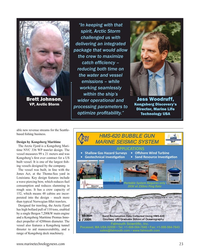 )
November 2023 - Marine Technology Reporter page: 23
)
November 2023 - Marine Technology Reporter page: 23• Tel: +1-508-564-7640 • Fax: +1-508-564-7643 thruster to aid maneuverability, and a [email protected] • www.falmouth.com range of Kongsberg deck machinery. www.marinetechnologynews.com 23 MTR #8 (18-33).indd 23 11/28/2023 10:47:34 A
-
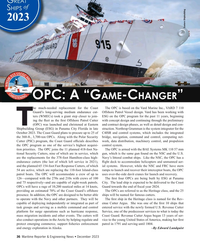 )
December 2023 - Maritime Reporter and Engineering News page: 36
)
December 2023 - Maritime Reporter and Engineering News page: 36Security bridge, navigation, command and control, computing net- Cutter (PSC) program, the Coast Guard of? cials describes work, data distribution, machinery control, and propulsion the OPC program as one of the service’s highest acquisi- control system. tion priorities. The OPC joins the 11 planned
-
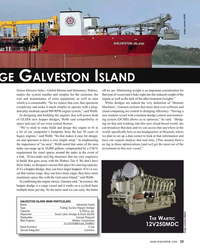 )
December 2023 - Maritime Reporter and Engineering News page: 33
)
December 2023 - Maritime Reporter and Engineering News page: 33capacity. If it’s a hopper dredge, they can have larger hoppers. If it’s a ves- sel that carries cargo, they can have more cargo, they have more machinery space like with the Galveston Island,” said Webb. In con? rming the engine choice, Gunsten said, “In essence, the hopper dredge is a cargo vessel
-
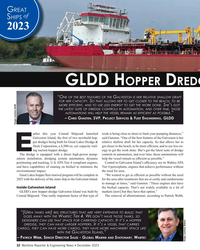 )
December 2023 - Maritime Reporter and Engineering News page: 32
)
December 2023 - Maritime Reporter and Engineering News page: 32T DREDGE THEY CAN HAVE LARGER HOPPERS F IT S A VESSEL THAT CARRIES , . I ’ CARGO THEY CAN HAVE MORE CARGO THEY HAVE MORE MACHINERY SPACE LIKE WITH THE ALVESTON SLAND G I ,” . I ’ , , – P W , S D S - G M S , WATRICK EBB ENIOR IRECTOR
-
 )
December 2023 - Maritime Reporter and Engineering News page: 28
)
December 2023 - Maritime Reporter and Engineering News page: 28job more working knowledge of power management systems and the ef? cient. The technology on this new series of ships is the computerization of the machinery, learning how reliant and show stopper, and in the case of Empire State VII the upgrade how integral computer software is to engine management
-
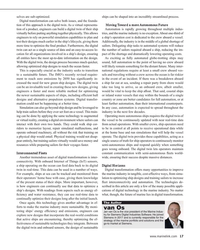 )
December 2023 - Maritime Reporter and Engineering News page: 17
)
December 2023 - Maritime Reporter and Engineering News page: 17need ridors to memorize layout, repair simulated malfunctions, and to be in control at all points to receive operational data while operate onboard machinery, all without the risk that training on at the home base and run simulations that will help the vessel a physical ship would entail. Physical training
-
 )
November 2023 - Marine News page: 49
)
November 2023 - Marine News page: 49islands and nourishing beaches an electrical power, propulsion, and building Group (ESG) this Spring de- lost to erosion, aiding the U.S. Army dredge machinery package by Royal livered R.B. Weeks, a 8,550 cubic yard Corps of Engineers and other key cli- IHC. It is equipped with twin Wabtec capacity trailing
-
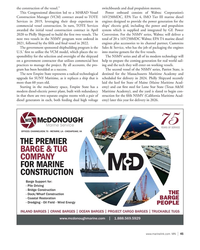 )
November 2023 - Marine News page: 45
)
November 2023 - Marine News page: 45scheduled for delivery in 2024. Philly Shipyard recently more than 60 years old. laid the keel for State of Maine (Maine Maritime Acad- Starting in the machinery space, Empire State has a emy) and cut ? rst steel for Lone Star State (Texas A&M modern diesel-electric power plant, built with redundancy Maritime
-
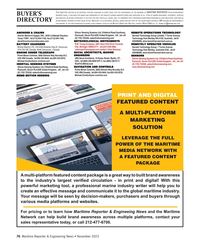 )
November 2023 - Maritime Reporter and Engineering News page: 76
)
November 2023 - Maritime Reporter and Engineering News page: 76OF QUICK REFERENCE BUYER’S READERS GUIDE IT INCLUDES THE NAMES AND ADDRESSES OF THE WORLD S LEADING MANUFACTURERS AND SUPPLIERS OF ALL TYPES OF MARINE MACHINERY EQUIPMENT SUPPLIES ’ , ’ , , AND SERVICES LISTING IS PROVIDED AT NO COST FOR ONE YEAR IN ALL ISSUES ONLY
-
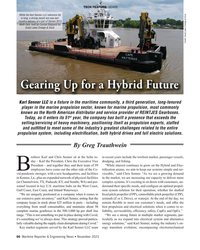 )
November 2023 - Maritime Reporter and Engineering News page: 66
)
November 2023 - Maritime Reporter and Engineering News page: 66provider of REINTJES Gearboxes. st Today, as it enters its 51 year, the company has built a presence that exceeds the selling/servicing of heavy machinery, positioning itself as propulsion experts, staffed and out? tted to meet some of the industry’s greatest challenges related to the entire propulsion
-
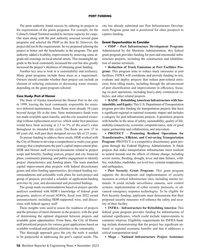 )
November 2023 - Maritime Reporter and Engineering News page: 58
)
November 2023 - Maritime Reporter and Engineering News page: 58PORT FUNDING The ports authority found success by tailoring its projects to city has already submitted one Port Infrastructure Develop- the requirements of the grants programs. For example, for the ment Program grant and is positioned for other prospects to Colonel's Island Terminal needed to increase
-
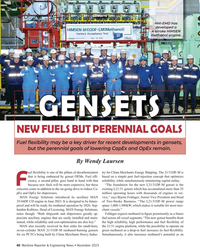 )
November 2023 - Maritime Reporter and Engineering News page: 40
)
November 2023 - Maritime Reporter and Engineering News page: 40GENSETS HHI-EMD has developed a 4-stroke HiMSEN methanol engine. Image courtesy of Hyundai Heavy Industries Engine & Machinery Division GENSETS NEW FUELS BUT PERENNIAL GOALS Fuel ? exibility may be a key driver for recent developments in gensets, but the perennial goals of lowering CapEx and OpEx
-
 )
November 2023 - Maritime Reporter and Engineering News page: 25
)
November 2023 - Maritime Reporter and Engineering News page: 25program, currently building vessel #3 and predictive modeling perspective and a product lifecycle man- the earlier vessels on which Austal’s automated machinery agement standpoint is critical; end-to-end performance-based control systems have been installed. Also, through Saildrone, logistics is possible
-
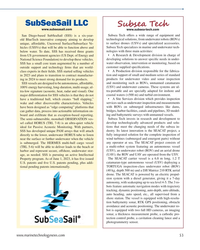 )
September 2023 - Marine Technology Reporter page: 53
)
September 2023 - Marine Technology Reporter page: 53SubSeaSail LLC Subsea Tech www.subseasail.com www.subsea-tech.com San Diego-based SubSeaSail (SSS) is a six-year- Subsea Tech offers a wide range of equipment and old BlueTech innovative company aiming to develop technological solutions, from underwater robots (ROVs) unique, affordable, Uncrewed
